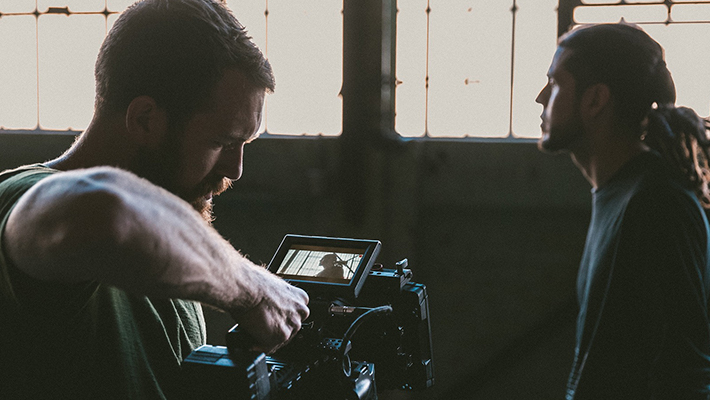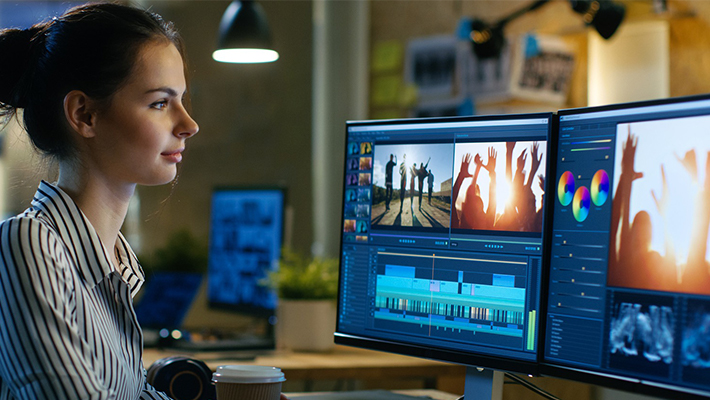Avoid not understanding the process and producing poor quality video content. Knowing what video production is and its process will help you create more exciting and relevant video content.

bluecranedigital.com gathered essential information and tips to help you define and understand what video production is and how it works.
Video Production Definition
Video production is the process of producing, capturing, and arranging media content for video. It can be considered the equivalent of filmmaking, but with video content recorded as analog signals on videotape, digitally on videotape, or as computer files stored on discs, hard drives, solid state drives, or memory cards versus film stock.
A videographer is often synonymous with video production, but it’s actually a camera operator that does one aspect of the video production process. They capture important footage that can be later edited and used for a variety of uses like advertising, product marketing, documentaries, etc. Consider the following video production phases:
1. Video Production – Development Phase
You will need more than just a good idea to make a video. You must develop that idea to come up with a polished and professional video product. To do that, you must:
- Clearly define who or what your video is for
- Determine what you are attempting to accomplish with your video
- Clearly identify your target audience
- Try to figure out or anticipate what your audience’s reaction will be after watching the video
- Define how to measure your video’s success after distribution
- Decide how you want to release or syndicate your video and define a distribution plan
All of the above will help guide your video production the rest of the way. If you follow all these steps well, you will have a good chance of attaining success with what you are about to make.
2. Video Production – Pre-production Phase

This phase is where you structure and define the groundwork necessary to make your video. This will include:
- Defining characters
- Writing scripts
- Making storyboards
- Rehearsing
This phase will also require you to do things like:
- Casting
- Assembling a crew
- Finding or purchasing the right videography equipment (including editing software)
- Determining filming locations and settings (location scouting)
Note: When filming indoors, studio lighting, props, and sound equipment for video production planning is also necessary.
3. Video Production – Production Phase
In this video production phase you capture footage and make the video itself. If you did all your pre-production steps in a meticulous, well-thought-out way, this stage should be relatively easy. With a good eye, attention to detail, and thoughtful planning from the previous step, you can piece together a special, well-planned video with very little stress or disruptions in the production phase.
4. Video Production – Post-production Phase

While in the production phase, you likely captured scenes that satisfied your objective’s needs and some that did not. Fortunately, you can edit or cut what you don’t like during this step. During post-production, you can add additional footage, special effects, music, subtitles, or whatever else you need to polish your video and reach your defined objectives.
This step in video production is where you can define your video’s emotional impact, clarify its messaging, and iron out any other issues, inefficiencies, or troubles.
5. Video Production – Distribution Phase
Now that you have a completed and polished video, it’s time to execute your purpose for making the video. This can be things like
- Showing it to people to share or communicate information and ideas
- Using it as a marketing tool for your business
- Upload it on social media to make a point or express an opinion
- Create a social media campaign
- Add it to an existing marketing or promotional campaign
- Syndicate it to local media outlets, writers, and bloggers
- Purchase advertising slots from television networks or streaming services
Tip: Hire a professional, experienced computer technician to fine-tune your website’s and social media platforms’ search engine optimization (SEO). SEO can leverage technology to increase your content’s viewership and place it in front of your desired audience.
You can do any of this and much more now that your video production task is complete.
Video Content Production
In this article, you discovered information, tips, and guidance on how to properly utilize each video production phase to capture and produce the best quality and most relevant video footage for your intended purpose.
Knowing the phases of video production will help you consistently produce high-quality material that you can use in campaigns, advertising, promotions, and information sharing.
Being ignorant to the processes and phases of video production will result in videos and a vision that are a fraction of their potential.
Sources:
lonestar.edu/33315.htm
ualr.edu/communications/video-standards/
ipr.edu/blogs/digital-video-and-media-production/what-are-the-phases-of-film-production/
apu.edu/static/src/sites/imt/downloads/video_production_guidelines.pdf
extension.colostate.edu/docs/comm/video-handbook2.pdf
